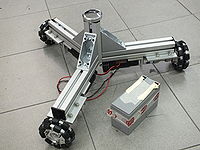Triskar2
Triskar2 is a highly modular, omnidirectional base, developed after some years of experience with omnidirectional robots Triskar developed for the Milan Robocup Team playing in the Robocup competition up to 2010.
Triskar2 is modular both from the mechanical, the electronic, and the SW points of view.
From the mechanical point of view it has been designed by adopting the Item modular system. Any mechanical dimension can be changed within hours. Each arm holding the motor is independent and can be locked on the central pillar in seconds. This also allows easy transportation. On the central pillar different "bodies" can be locked.
From the electronics point of view, it adopts R2P, the modular architecture developed at AIRLab by Martino Migliavacca. Independent, low-cost, HW modules implement the single functionalities (such as motor control, communication, sensors,...) and it is connected to the others via a CAN bus, participating in a publish-subscribe architecture supported by the real-time operating system ChiBiOS. This means that interaction among modules is implemented in real-time. Modules include an ST Microelectronics ARM processor on which the basic functionalities of the module are implemented. Therefore, any robot HW can be implemented in hours.
R2P exposes a [MicroROS] interface, enabling each R2P node to interact directly to any ROS node implemented on a connected computer or network.
Triskar2 is currently under development as a base for some Robogames, the most advanced of which is presently Alien-Bot.

